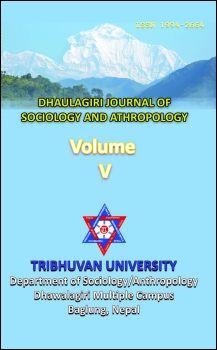Kulpuja: A Ritual and Behavior of Magar
DOI:
https://doi.org/10.3126/dsaj.v5i0.6366Keywords:
Ancestor, ritual, the Magars, behavior, sacrificeAbstract
Human beings take themselves superior for having the capacity of development of culture to their environment for survival. From the beginning of civilization, people prepared, accumulated the knowledge and preserved it as a form of culture. Culture is the body of thought and knowledge both theoretical and practical, which only man can possess. It is the sum total of achievements which develops traits by traits. Among them kulpuja ritual is one of the central traits. In this paper, I explore why rituals like kulpuja are celebrated and what relation they have with the behavior of the indigenous people—the Magars of Langaun of Baglung district, western Nepal. The research was carried out by using descriptive and explanatory research design. Participant observation, group discussion and key informant interview were carried out to collect the primary data. The Magars are rich in their ritual activities; among them kulpuja is the most important one. Like other castes and many ethnic groups of the world, the Magars of Langaun also sacrifice and offer chicken and black pig’s heart for their ancestral god. They believe on supreme power which is able for the termination of the evil eyes as well as other obstacles and illness by the happiness of their ancestral god. The offering of a live heart is a unique feature which is carried out emotionally. The rate of generation gap is clearly seen between the members of Magars. The elders are worried about the increasing rate of dependency in their offspring and feel how the children are able to survive within their environment. The importance of this ritual bind among the members of the community is deteriorating continuously in the name of modernization in younger members of the community.
DOI: http://dx.doi.org/10.3126/dsaj.v5i0.6366
Dhaulagiri Journal of Sociology and Anthropology Vol. 5, 2011: 235-46




